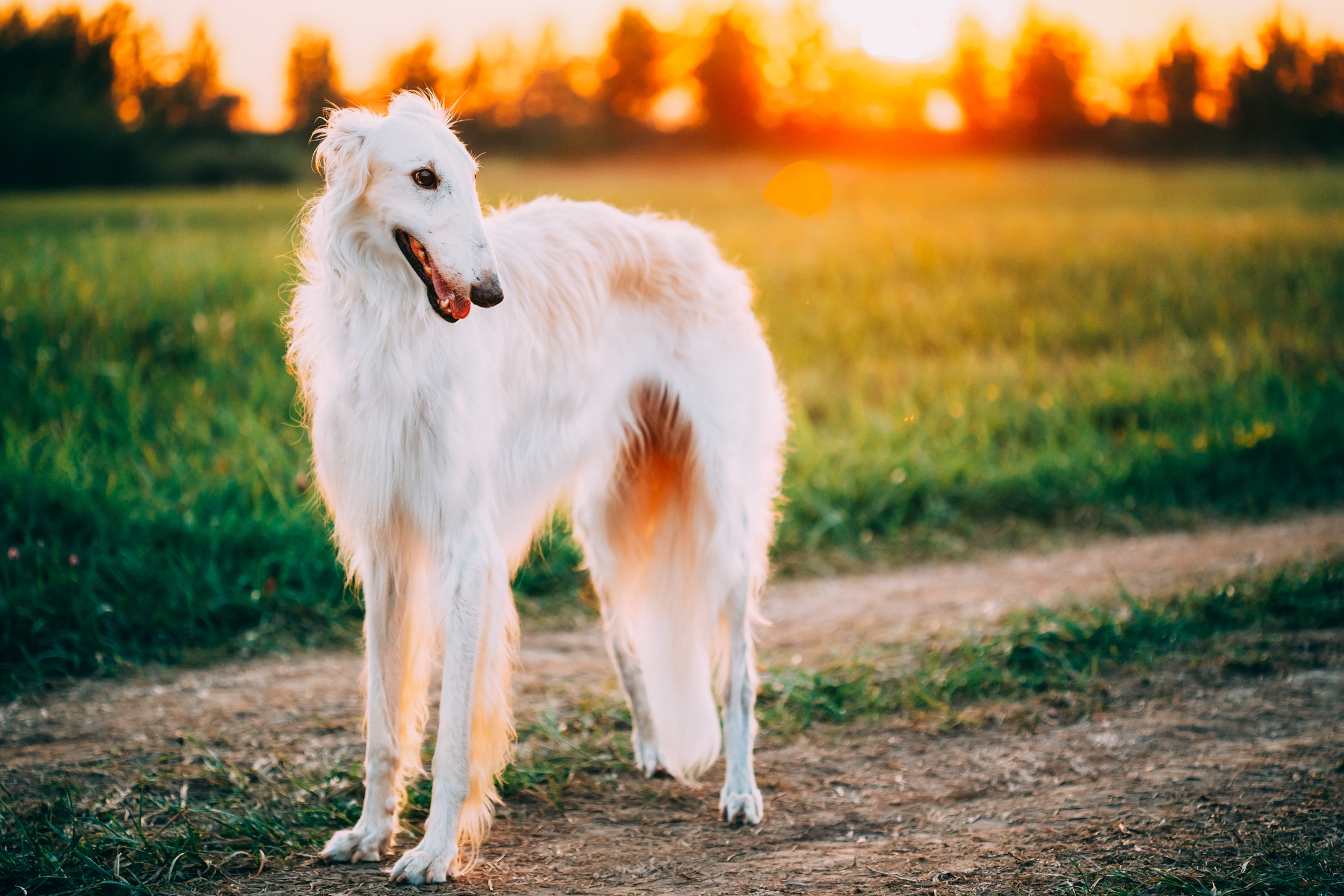
Genetic diversity in the Borzoi
Dr. Niels Pedersen recently published a final breed report on the Borzoi! What did UC Davis’ professor emeritus Dr. Niels Pedersen DVM, PhD find with regard to the Borzoi in this analysis? The following article summarizes the full breed report written by Dr. Pedersen. You can find the full report here.
This report is based on the testing of 117 carefully selected Borzoi; chosen to represent unrelated bloodlines within the breed. It is of note that the original report for Borzois was created based on 31 tested dogs, and we have not seen much change in the numbers since. This goes to show that a very carefully selected initial sample can be very telling about the status of a breed.
How inbred is the typical Borzoi?
A part of the UC Davis canine diversity test is a calculation that estimates how inbred a dog is. This estimate, called Internal Relatedness or IR, is a positive measure from 0 to 1 when a dog is inbred, and a negative measure from 0 to -1 when the dog is outbred. An outbred puppy would inherit genetics from its sire that were very different from those it inherited from its dam. An inbred puppy would inherit many of exact same genetics from both dam and sire. Being outbred reduces the likelihood of known and unidentified recessive component diseases expressing in individuals.
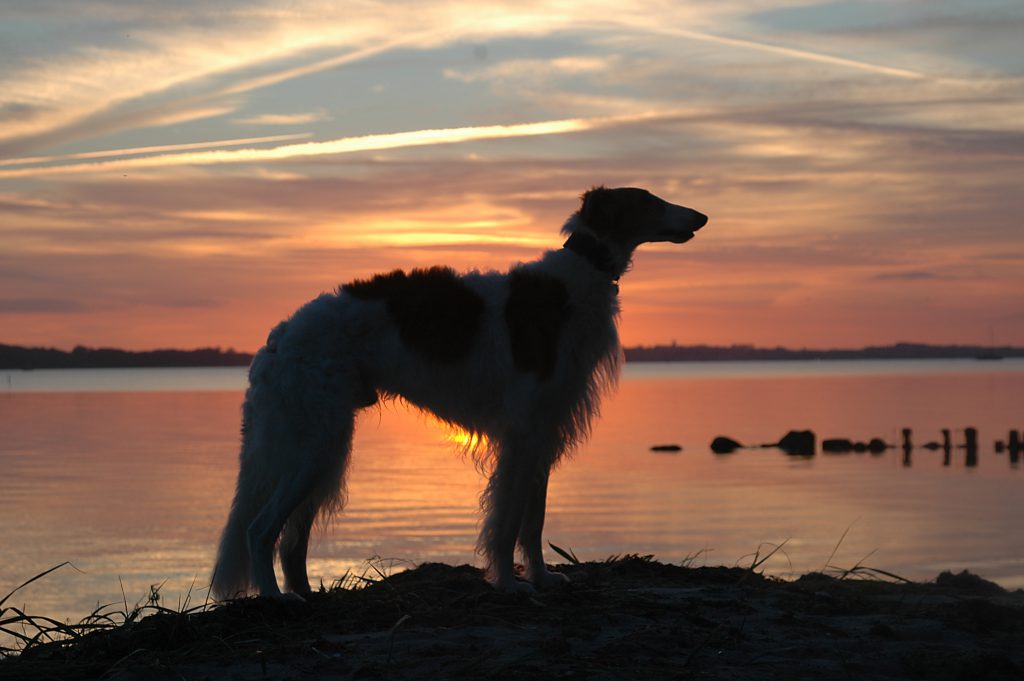
So, how inbred or outbred are the individuals in the Borzoi breed?
From the report:
The 25% of most outbred dog in the population had an IR scores of -0.271 to -0.302, while the 25% of most inbred dog in the group had an IR score of 0.154 to 0.351, while the mean (average) IR score for the group was 0.034. Therefore, IR values give a different picture than seen with the population average scores from the standard genetic assessment (Table 2). While the standard genetic assessments indicated a population in HWE, the IR scores showed a population of individuals that ranged from reasonably outbred to highly inbred.
Dr. Niels Pedersen
To translate – a portion of the breed has very high levels of inbreeding, and because we can’t necessarily detect this without DNA testing and analysis, they could benefit from predictive software aiding in selection of breeding mates, to ensure that future breedings are not too close, risking health as a result.
How much biodiversity exists in the Borzoi today?
Dr. Pedersen analyzes the data collected from the VGL canine diversity test in many different ways in order to assess the total amount of biodiversity within each breed. Many of these measures together give us an overall picture of the state of the breed and as a result we can make informed decisions on breed management.
The best explanation I’ve yet read is from BetterBred Founder Natalie, and as a result we will share it again here!
Most breeders think of DNA as coming in two options- a good gene, or a mutant gene – like it is in many DNA tests. In fact, there can be many versions of each gene or (in this case) marker in a single place on the DNA – like a t-shirt that is available in different colors. The more variants there are, the more information we have about the population genetics of a breed. In more inbred breeds, there are fewer variants for each marker. So to use our analogy, an inbred breed might have only a few colors available in t-shirts, whereas a diverse breed will have t-shirts in many colors. Apart from the relatively small number of genes that make up specific, visible breed traits, the rest of the gene pool is generally healthier when there’s a lot of variation for each marker.
Unfortunately when breeders select too strictly for too long and for very specific traits, there can be an unintended loss of variation in the parts of the DNA that thrive with more variation. A good way to assess whether that good variation has been impacted is by using the markers found in the VGL canine diversity test. Because they are considered neutral – or not associated with any specific known trait – they are great for assessing genetic diversity. In breeds with ample diversity, there will be lots of variations for each marker (lots of colors in the t-shirt drawer.)
But what if you have a breed without much variation? Well, this happens, and can happen quite often. In this case the best thing breeders can do is try to make sure the variants that are in the breed are well distributed – so there are plenty of all of them in the breed. Imagine a t-shirt drawer with lots and lots of red t-shirts but only one blue t-shirt and one green t-shirt. If you lose one of the red ones, it doesn’t change much about the t-shirt drawer – there are lots of other red ones. But if you lose either the blue or green one, the variation is seriously diminished. If, on the other hand a third of the shirts are red, and a third are green and a third are blue, then it’s a lot harder to lose the existing variation in the drawer, even if you lose one once in a while, and even though there are only 3 colors.
The Borzoi’s biodiversity
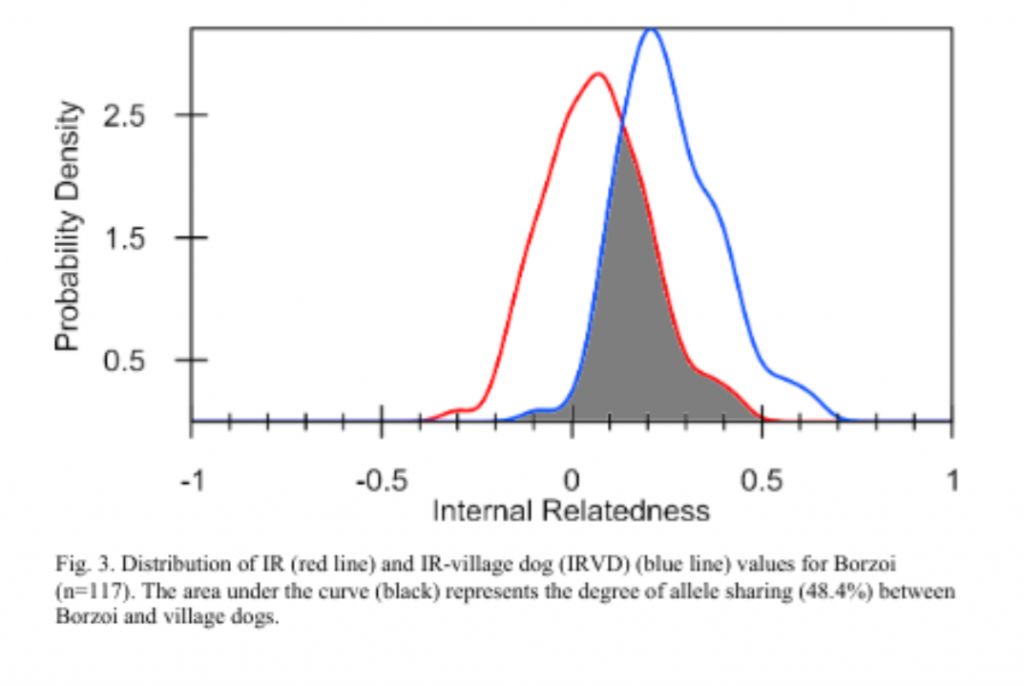
Another use of an individual’s inbreeding value: we can look at the inbreeding level of all individuals in the breed in aggregate – meaning the whole breed altogether. When a whole breed is very inbred on the same few ancestors, it can result in very little remaining biodiversity within the breed. Then, by adjusting those inbreeding values in comparison to the data from village dogs (often considered “ideal” for biodiversity), researchers can estimate the remaining biodiversity of a breed compared to all the diversity that once existed in dogs prior to breed formation.
So when this investigation was done for Borzoi, what did Dr. Pedersen see?
The IRVD curve for the Borzois tested was shifted to the right of the IR curve, and the area of overlap was 48.4% (Fig. 3). This figure is close to the 40.9% of retained genetic diversity calculated from a somewhat different population, i.e., all canids ever tested at the VGL (Tables 1, 2). This level of retained village dog genetic diversity is lower than the 60% or so retained diversity observed in the Miniature/toy Poodle or 54%in Labrador Retriever, and much higher than the 23% for Irish Wolfhound, 15% in Doberman Pinschers and 7% in Swedish Vallhund. All pure breeds of dogs have come from relatively small founder populations, which has limited genetic diversity from the time registries were created and closed. Greatly varying amounts of genetic diversity may have been lost subsequently through artificial genetic bottlenecks such as cataclysmic events (e.g., world wars) or inbreeding for a specific show conformation (e.g., popular sire effects).
Dr. Niels Pedersen
This assessment indicates that there has been a depletion of genetic diversity in this breed compared to the “ideal”, but let’s look at the data another way:
A secondary way to estimate the loss of biodiversity due to breed formation and breeding choices post-formation is to look at the average number of alleles found at each tested locus and to compare those to the village dogs. When looking at the number of alleles found, we might consider two things: the average number of alleles found in total (Na), and the average number of alleles that are effectively contributing to the population (Ne – effective alleles). Going back to the t-shirt analogy above, say we have 10 t-shirts, and 8 of them are red and one is green and one is yellow. The total number of shirt colors is 3, however the majority color is red, therefore our “effective” t-shirt color would be only 1.
So, if we look at these numbers what do we find out about this population?

Dr. Niels Pedersen
Using the 33-marker panel, the 117 Borzois had an average of 6.42 alleles/loci (Na). This is higher than for the Shiloh Shepherd (Na=4.0), Lakeland Terrier (Na=4.24), Swedish Vallhund (Na=4.91) and Irish Red and White Setter (Na=5.09); similar to the Llewellin Setter (Na=5.94) and Flat-coated Retriever (Na=5.94);but lower than large and genetically diverse breeds such as the Labrador Retriever (Na=7.33), Golden Retriever (Na=8.39) and Miniature Poodle (Na=8.91). However, the average number of alleles is less important than the number of alleles that have the greatest genetic influence on heterozygosity, a figure known as average effective alleles/loci or Ne. The Ne in this group of dogs averaged 3.42 effective alleles per locus.
(…)
On average, the alleles identified in this group of 117 dogs represented 6.42/15.4=40.9%of alleles known to exist in all canids tested at the VGL. This is higher than the Swedish Vallhund(31.9%), Flat-coated Retriever (38.6%), Irish Red and White Setter (34.8%); identical to the Magyar Agar (40.4%); but lower than breeds such as the Golden Retriever (54.5%), Toy Poodle (55.6%) and Standard Poodle (58%).
This number predicts that the Borzoi has retained 40.9% of the existing biodiversity available to canids; this number is comparable to the estimate from the IRVD, which estimated a retention of 48.4% of existing biodiversity.
Additionally, Dr. Pedersen discovered that the breed is only effectively using about 53% of it’s total available biodiversity (Ne/Na). How does a breed community increase this? They identify individuals who may have unusual genetics for the population, and work to preserve those genetics and redistribute them in the population at large.
Breed relationships
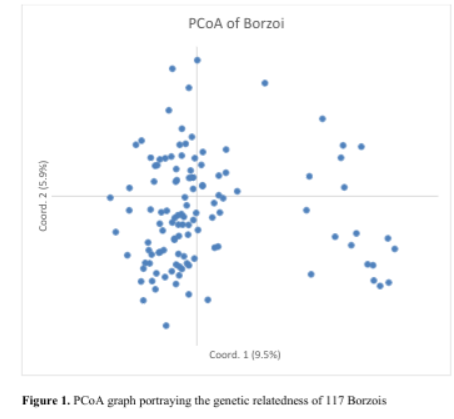
Another use of the data from the VGL canine diversity test is to see how the individuals within the population fit in relation to one another. What do we see when we look at this analysis, called the PCoA graph?
The 117 Borzoi formed a single population (i.e., breed) divided into two genetically distinguishable groups by PCoA (Fig. 1). As expected, the main population clustered around of the XY axis, while a smaller but genetically diffuse population of 19 dogs clustered to the right of the XY axis.This smaller group contained dogs from a single popular kennel and a bloodline based on an outstanding foundation bitch. Her desired traits have been maintained by strict line breeding. It is uncommon for bloodlines to differentiate to the degree of varieties within a breed.
Dr. Niels Pedersen
This is the first time that we have seen an individual line significantly clustering away from the rest of the breed to the extent it could be considered a variety. This existence of a different line would be a good location to seek biodiversity, for those interested (and vice versa). However, often times when these differences are seen, people can be tempted to claim that a line is not purebred. For this reason, we also look at breeds in relation to other breeds to see a more “big picture” view.
Dr. Pedersen chose to compare Borzoi to the Irish Wolfhound and the Irish Red and White Setter. In this comparison, it appears there are individual Borzois that may be outliers in comparison to the rest of the breed. From the report:
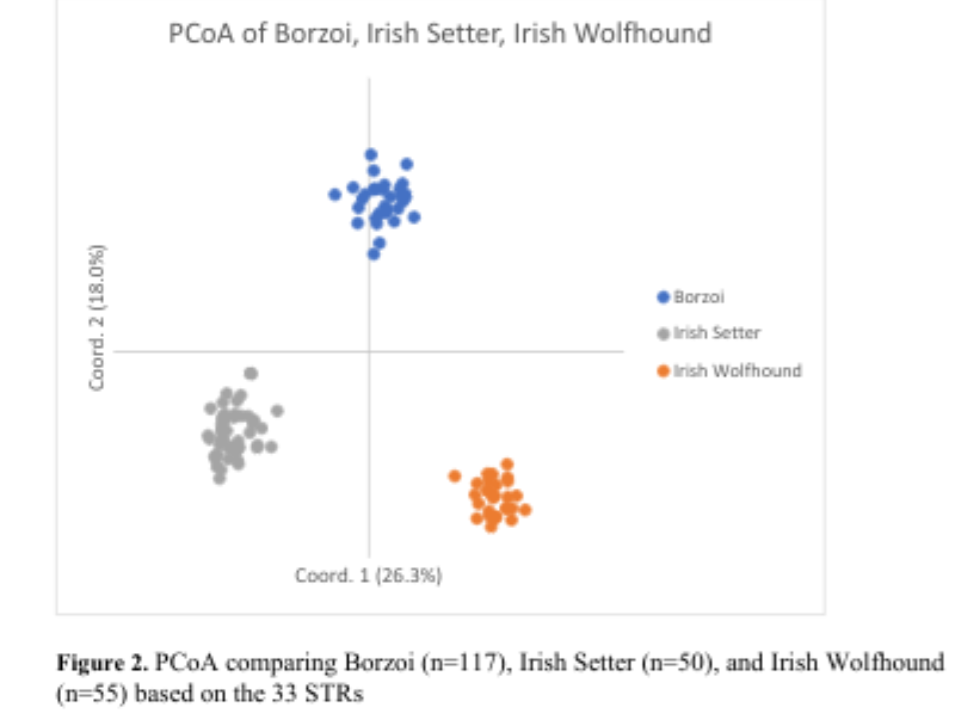
The degree of relatedness of individuals within a breed can be further emphasized by comparing the 117 Borzoi with genetically distinct breeds, such as the Irish Setter and Irish Red and White Setter(Fig. 2). These breeds have parallel histories and are from the same region. This comparison shows the three breeds to be genetically distinct, but with tightening in the relationship of individuals within each breed.The two varieties seen in Figure 1 have now been merged into a single cluster or breed.
Dr. Niels Pedersen
The immune system
The UC Davis VGL canine diversity test can identify more regions of the DLA than any other test available today. The Dog Leukocyte Antigen, called the DLA, is the region of the DNA that codes for the immune system in the dog. There are three regions, Class I, Class II and Class III. This test identifies both Class I and II haplotypes. (A haplotype is a tightly linked group of genes within an organism that is inherited as a group from a single parent.) To learn more about the DLA, read here.
From the report:
The 117 Borzoi in this study possessed 15 DLA class I and 11 DLA class II haplotypes (Table 5). Six class I (1215-1217, 1219, 1223, 1241) and one class II (2116) were unique to the breed and the rest shared with several other breeds (Table 6). One class I (1160) and one class II (2022) haplotypes occurred in 59% of the dogs tested, while another class I (1006) and class II (2007) haplotype were observed in 15% of dogs. These high incidence haplotypes found in 73% of the dogs were in strong linkage disequilibrium (LD), forming larger 1160/2022 and 1006/2007 haplotypes. All the remaining haplotypes occurred at incidences ranging from 1-9%. The number of DLA class I and II haplotypes found in these 117 Borzoi was low compared to many other breeds studied to date. The numbers of DLA class I (n=10) and II (n=9) haplotypes found in Borzoi were higher than the Swedish Vallhund (6/4) and Shiloh Shepherd (7/6); somewhat lower than Giant Schnauzer (14/15), Samoyed (13/12) and Shiba Inu (16/15); and much lower than Golden Retriever (26/23) and Miniature Poodle (33/23). If these 117 dogs represent the ancestry of the breed, two founder dogs or closely related bloodlines have played dominant roles in breed creation and/or evolution. However, the fact that several low incidence haplotypes appear to be unique to the breed indicates that additional dogs were also important to the breed’s standard and their genes closely preserved
Additionally, the report notes that the Borzoi share DLA haplotypes with the following breeds in particular, Black Russian Terriers, Havanese, Irish Red and White Setter, Labrador Retriever, Doberman Pinschers, Samoyed, Giant Schnauzer, Shiba Inu, English Bulldog and American Akita
In summary on the DLA: The Borzoi have two DLA haplotypes contributing to the immune system of the majority of Borzoi – while there are several DLA haplotypes that are not well represented. Breeders can use this testing to redistribute these haplotypes so that they are not lost to drift. As stated by Dr. Pedersen in his conclusion below, the lack of biodiversity in the DLA is of note, but uncertain what it would mean for the breed.
Conclusions
The following conclusions from Dr. Pedersen sum up the findings from the 117 tested Borzoi.
The Borzoi tested constituted a single breed, albeit with limited genetic diversity and some intra-breed variation to the level of varieties.Some of this variation could be explained by relative isolation, e.g., the popularity of certain bloodline(s). The breed originated from dogs that shared many of their genomic alleles with village dogs currently found in the Middle East, SE Asia and Island Pacific nations. Their DLA haplotypes are also shared with several other breeds that evolved in both Europe and Asia. However, a portion of the Borzoi genome also came from founders that are not represented in any other breed tested to date.
The Borzoi lack diversity in the DLA regions. Seventy three percent of the individuals tested possessed one or two copies of the 1006/2007 or 1160/2022 class I/II linked haplotypes. This is evidence that two founders, or closely related founder lines, have contributed disproportionately to the breed’s evolution. However, the fact that these haplotypes are in equilibrium with the rest of the genome indicates that this imbalance occurred at the time of the founding and has become fixed/equilibrated over the time, and not from some more recent genetic bottleneck.
Although it appears that contemporary Borzoi have a relatively narrow genetic base, a lack of genetic diversity is not in itself bad, providing the founder population was relatively free of deleterious genetic traits and breeders have been judicious in avoiding any artificial genetic bottlenecks that may cause either a loss or imbalance of original diversity. The breed is surprisingly clear of breed-specific heritable disease traits and enjoys a good lifespan compared to other large dog breeds. The health problems that exist are of a complex genetic basis and are common to many dog breeds and even mongrels [11]. These traits common to modern dogs have most likely been inherited from [16] generation to generation as dogs underwent progressively more intense human-directed artificial selection.
The lack of genetic diversity in the DLA class I and II region of these 117 Borzoi is noteworthy, but it is uncertain what it means. Certain DLA class I and II haplotypes have been associated with specific autoimmune diseases in certain breeds[13], but autoimmune disorders other than hypothyroidism have not been documented as serious problems in Borzoi. Nevertheless, it is important that breeders maintain as much diversity and heterozygosity in the DLA region as possible.
Breeds that lack genetic diversity must be managed much more closely to avoid further loss of genetic diversity and have less leeway in dealing with simple recessive or complex polygenic disorders that might arise. Elimination of deleterious traits may result in loss of genetic diversity, especially when diversity is limited.
Dr. Niels Pedersen
Based on this report, the Borzoi have maintained an average amount of biodiversity as compared to other breeds that have thus far been tested. It will be of great importance to conserve the existing biodiversity so further depletion does not occur due to random loss of alleles – called genetic drift. Breeders can do this by testing their dogs and placing a priority on healthy dogs with less well represented genetics in comparison to the rest of the population, provided they are good representatives of the breed. Using our tools designed to identify these individuals, Average Genetic Relatedness (AGR) and the Outlier Index (OI), breeders can assess these dogs for selection as mates, as well as simulate what to expect in potential litters. Special attention might be warranted to preserve the less typical DLA haplotypes so they are not lost to genetic drift.
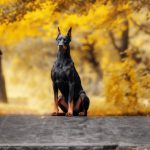 Previous Post
Previous Post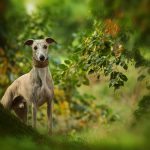 Next Post
Next Post


